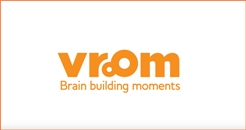 Vroom - boosting a child's learning
Vroom - boosting a child's learning
Vroom is a free app designed to stimulate parent-child interactions with brain building activities. It was created by the Bezos Family Foundation, (Jeff Bezos is founder of Amazon), in partnership with the Center for the Developing Child at Harvard University. The app is for parents and educators and contains over 1,000 brain-building interactions you can do with your children.
The way that it works is you simply enter the age of your child and their first name and you start receiving activities that are age appropriate immediately. The Vroom web site also has a lot of resources in various languages.
All of the activities are designed to empower. If you’re doing laundry, at the dentist office or in the grocery store, you can choose activities that would be a good fit in that location. As your child grows, the app adjusts the activities to suit their age range.
The goal is to put this tool in the hands of as many families as possible so they can positively interact with their children and help develop their brains. With Vroom, you read the activity on your phone, then put the phone down and interact.
The biggest benefit for early childhood professionals e.g. teachers, is just the amount of content that’s available. If you go on Vroom’s website, there are playbooks on how to incorporate it into the classroom. For teachers, it’s the same as parents – you’re looking for content and resources.
Let's look at a couple of daily suggestions:
Weighing In:
As you fill your shopping cart, ask your child: "What is heavier? A box of tissues or bag of potatoes? An orange or box of cereal? A tube of toothpaste or carton of milk?” Invite them to guess. Then let them hold one in each hand to find out.
Background
Hands-on experiences like these help your child learn to think like a scientist and to observe the world around them by predicting and testing their hypothesis.
Shape of the Day
Before leaving the house, invite your child to choose a Shape of the Day. While you’re out, search for that shape together. If they choose a circle, look for circles like traffic lights, signs, and wheels. Talk about what you both notice: They're all circles, but what is different about them?
Background
By pointing out shapes and counting together, you make math fun and interesting to your child, which helps them build a foundation for later learning. When talking about what’s the same and different, they learn to make connections, a skill that is at the core of learning.
Here's a 2 minute video about Vroom:
Retweet about this article:
Geoff Knott, 06/03/2019